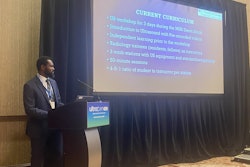Personal interest, enjoyable rotations, and favorable work hours are key factors in U.S. diagnostic radiology residents deciding to pursue fellowship, according to a study published January 19 in Current Problems in Diagnostic Radiology.
Researchers led by Evan Hicks from the University of Arkansas also found that neuroradiology, musculoskeletal, and body imaging are the most popular specialties. However, they highlighted an increase in interest in breast radiology.
"Our results demonstrate that few first-year residents make the decision of fellowship, which is understandable. However, we also know personal interest is the leading factor," Hicks told AuntMinnie.com. "Personal interest can grow early in the process and when combined with an enjoyable rotation, residents will flock to their program’s fellowship."
Traditionally, many residents in diagnostic radiology pursue fellowship. However, with job market changes and the lingering effects of the COVID-19 pandemic on the profession, the Hicks team explored current trends in radiology fellowship choice. It analyzed factors influencing decisions made by radiology residents in pursuing a fellowship.
The researchers collected survey data from 214 radiology residents, representing 4.6% of U.S. diagnostic radiology residents across 199 programs. They reported that the top fellowship choices included neuroradiology (20.5%), musculoskeletal imaging (17.3%), body imaging (16.8%), and breast imaging (16.4%).
The breast imaging interest report is higher than previous studies, which show that 5%-8% of graduating radiologists entered breast fellowship in the past.
The study authors suggested that the increased interest seen in their study could be due to job market stability, flexible work schedules, and low call and emergency responsibilities. Still, they called for more studies to better understand this trend.
The team also used a 0-to-100 scale for survey respondents to indicate which factors influenced their fellowship choice.
It found that strong personal interest in the field was the most influential factor with a median score of 85. Other strong influential factors included the following: enjoyable rotation in the specific radiology subspecialty influenced their choice (median score, 80), favorable work hours (median score, 75), job security (median score, 75), financial compensation (median score, 74), and geographical considerations (median score, 73).
However, the least influential factor reported by the respondents was research opportunities with a median score of 14.
The study authors suggested that residency and fellowship programs should emphasize the factors identified in their study to attract more fellows. They added that programs can also offer more early exposure to subspecialties during residency.
Hicks told AuntMinnie.com that the team next wants to investigate the increased interest in breast radiology, the relationship of the current job market in geographic regions to specialty choice reported by respondents, and how subspecialty interest can be increased among medical students.
The study can be found in its entirety here.



















